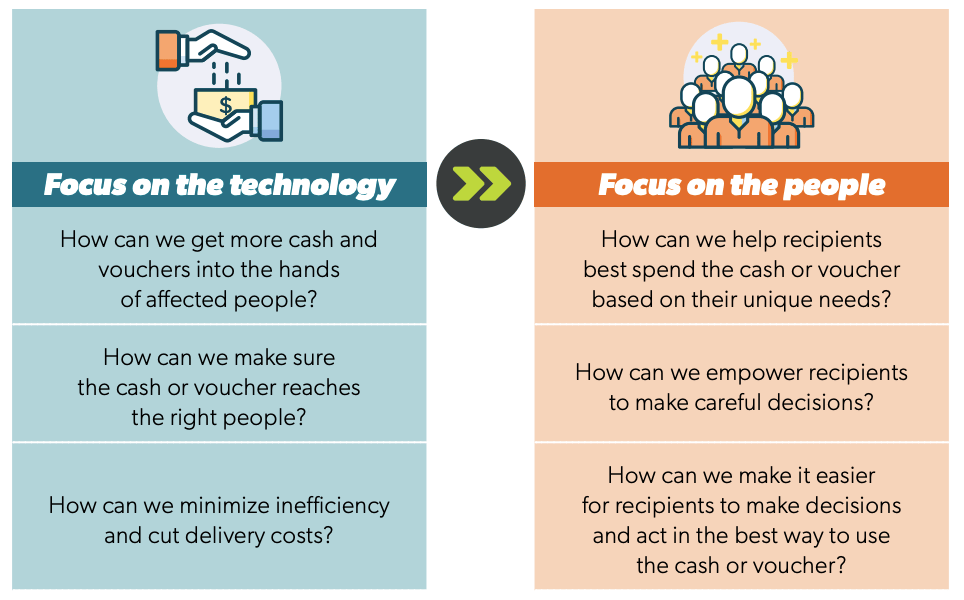Cash and voucher assistance changed humanitarian response forever. In 2015, the High Level Panel on Cash Transfers directed humanitarian agencies to implement unconditional cash transfers at scale whenever possible, and the advice was heeded. Preliminary findings suggest an estimated 60 percent scale-up of total cash and voucher delivery from 2016 to 2018—from US$2 billion in 2015 to US$4.5 billion in 2018. The rise of unconditional cash transfers has had a powerful impact on populations affected by humanitarian emergencies. It has proven to be a strong alternative to in-kind assistance where markets are functioning and can meet demand—it not only provides flexibility to people in need but contributes to dignity as recipients decide how to spend the transfer for themselves and their household, as well as supports small-scale businesses and local economies.
Despite the positive growth of cash and voucher assistance in recent years, the increasing number of people affected by humanitarian crises without a matched increase in donor support has compelled humanitarians to make funding stretch further. As a result, humanitarians continue to ask themselves—how can unconditional cash transfers be made even more impactful and still allow people to best decide and act on their needs? The primary answer to this question in recent years has been innovation in technology and operations most synonymous with electronic delivery mechanisms, involvement of private sector actors, or collaborations and operational models.
But beyond technology, there are more tools within the humanitarian community’s reach to enhance the power of cash and voucher assistance by focusing on the most important people—the recipients. In particular, the field of behavioral science—the science of how people make decisions and take actions in the real world—offers a fresh source of innovation to increase the impact of cash and voucher assistance for recipients.
In line with this effort, ideas42 and CARE International collaborated to identify how we could use behavioral science to maximize the impact of cash transfer programs for women recipients in CARE’s programs in Iraq, Jordan, and Turkey. CARE International is dedicated to a gender-sensitive approach to cash and voucher assistance and consistently seeks to understand how to make sure that programs can have the best outcomes for women—based on their needs, capacities and aspirations. The approach aligned perfectly ideas42’s focus on ensuring that programs are informed and designed according to the science of how people make decisions and take actions, which allows people to make their best decisions and take the best course of action for themselves and their households.
Together, we identified that although the structural challenges in humanitarian settings can be huge—such as limited resources to support affected populations, persistent economic shocks to households, or legal and regulatory constraints to banking and formal employment—small programmatic tweaks and behavioral interventions can more effectively maximize the impact of cash and voucher programs in these settings. We identify these insights in our recently published guide on Applying Behavioral Science to Humanitarian Cash & Voucher Assistance for Better Outcomes for Women and accompanying Behavioral Design Checklist.
Here’s one insight: prime women to affirm and “activate” positive aspects of their identity during the cash and voucher assistance process. Women receiving cash transfers in the researched settings often already have a wealth of experience in managing household needs—they’re essentially leaders in their own homes, but often have not considered themselves as such in the outside world, leading them to feel unconfident in receiving a transfer.
Humanitarian organizations can “activate”—or bring to the forefront—their existing identities as capable leaders and household managers at the moment of transfer. Priming— subtly nudging individuals into thinking about a particular aspect of their identity—has been shown to improve cognitive performance during and just after the moment of affirmation. Sending positive affirmations to women via text or voice messages shortly before receiving cash could improve cognitive performance when receiving and using the transfer. In addition, in cash programs with case management components, case managers could conduct self-affirmation activities with women to increase confidence and performance in managing their household needs.
This is just one example of how we can bring behavioral science to humanitarian cash and voucher assistance to improve outcomes for women—and in simple and cost-effective ways.
Overall, we know that humanitarian aid is growing at a minimal rate and concentrated in a few contexts, while the number of people affected by humanitarian crises globally expands each year. This implies that humanitarians will have to do better with the support provided to crisis-affected populations. As such, we need innovations that are cost-efficient, scalable, in line with the future of cash and voucher assistance, and that keep intended recipients’ needs and desires at the center. Applying behavioral science to cash and voucher assistance can do just that.
CARE International is a leading humanitarian organization fighting global poverty. Founded in 1945 and working in 100 countries, CARE places special focus on working with girls and women.
ideas42 is a non-profit design and consulting firm that uses insights from the behavioral sciences to address complex social problems. Since 2009, ideas42 has partnered with foundations, non-profits, government agencies, and socially-minded companies to work on more than 250 projects in over 45 countries, using behavioral science to improve tens of millions of lives around the world.




